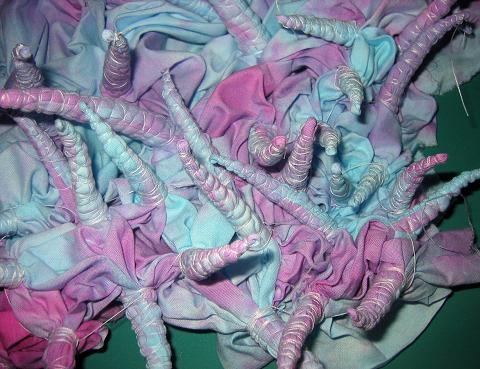I have a secret project that I’ve been working on so I can’t blog pictures of it until later after the gift has been received but I can blog the fabric I made that’s a part of the gift.
I love Shibori (The Japanese art of fabric tying and folding) but really have been too lazy to try out many of the techniques as they are fairly labor intensive, it was always “some day”. Well I haven’t done much lately in the way of dyeing so decided now would be an opportunity to try out some Kumo or Spiderweb shibori for the piece of fabric I had in mind for my project.
I started out dyeing a parfait in turquoise and fuchsia, not too dark as I wanted contrast between these colours and the overdye I had in mind.

The photo is on the dark side.
Next I used a Japanese tool that screws onto a ledge and has a fine pick/needle to hold the fabric while you work on it. I’d tell you the name but the box is written in Japanese.

Shibori tool for holding fabric while you tie it off.
Next I bound the fabric with nylon thread spaced throughout the yardage. I started off with fairly big spiderwebs but then as I grew more used to tying off the webs I spaced them closer together. I had started off tying each kumo separately but then read a book and realised that I didn’t have to do that and just went from kumo to kumo carrying along the thread as I went securing it at the base of each kumo before moving on.

Fabric all bound up with kumos otherwise known as spider webs.
After binding all of my fabric I soaked it for about 1/2 hour or so in soda ash solution and then spun it out in the washing machine to get rid of excess solution (make sure you don’t rinse). I then made up some dye solution of ProChem’s eggplant and put the fabric into a container and poured the dye on top. I then let the material batch for about three hours before rinsing and washing out.

Over-dyed fabric with eggplant.
Using a stitch ripper I very carefully picked out the nylon thread and spread out my beautiful shibori. I decided to wash the fabric once again just in case any excess dye was left over from being trapped in the folds of material.

Thread removed.

Opening folds.

Fully opened.
After drying the fabric I ironed it.

Ironed fabric.

Closeup of the spider web and the thread lines caused by the resist of the nylon thread.
I have to admit that I was quite impressed with the results, lol, I don’t want to cut into this but what am I going to do hoard it? It looks pretty good with the project it will be paired with.
Edited to note: I have had so many requests for where I got the tool that my next posting has the link for the page on the Maiwa website as well as some closeups of the tool in case people want to try to make their own.
Karen

Pretty cool! You did a great job on that!!!
Oh wow, that’s cool!
great looking fabric, Karen. So you rinsed it out with the fabric still wrapped and then overdyed it?
I guess I am curious why you overdyed it. did you
think it wouldn’t be dark enough or the right color
without overdyeing?
as for hoarding or using it. Use it. You now know
how to create the fabric and I expect you will want
to do it several more times. ann
WOW that turned out great whoever ends up with it will surely love it.
I wrapped the parfait and then over-dyed it. I rinsed it out to get rid of the purple over-dye before taking out all the thread.
It’s hard to tell but the turquoise and fuchsia are the lighter colours under the purple.
That turned out great. Good job!!
Now that is awesome!! Where did you purchase that Japanese tool from? I so want to try this technique. Did you get it out of a book? If so which one?
So the mind boggled when I first saw the picture of all those little pointy bits of fabric tied up with string – but the end result was sooooooo worth it. Love the effect. Hey don’t worry about using it – now you have made one you can make more….wicked grin. I had no idea you could buy tools for doing that kind of thing – what will they think of next.
karen-
would you share the source for the japanese kumo tool? i have improvised my own clamp devise for this purpose and i knew this device existed but have not come across it myself. people are always asking me for this!
your purple cloth is lovely!
This is GORGEOUS!
Beautiful fabric! I would love to know the source for the tool also.
Beautiful work!
This is really spectacular!
Wow, this is gorgeous. And I’m really excited to see that tool. Have you watched the DVD about the history of shibori?
http://www.dharmatrading.com/products/asmdvd.html
It’s terrific. They use a modified version of this tool throughout the video. Lots of ancient looking folks moving their hands very very fast!
My goal is to have my husband make that tool. It doesn’t look like it would be too difficult.
I haven’t seen the video yet but I have seen a few clips of the people working shibori.
Your husband should have no problem making the tool I would think and save yourself a lot of money.
need shibori fabrics,,, lemme know if you r interested,,, i m from india,,,
Thank you but no.
Hello,
I am in Tokyo, Japan till june 12.
Could you tell me the name and where I can buy the shibori tool that you have been using ?
Thanking you in advance..